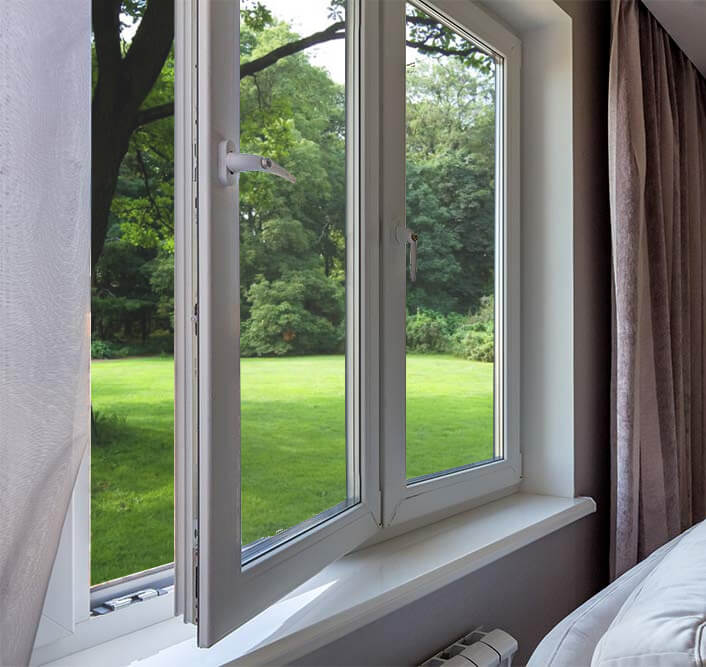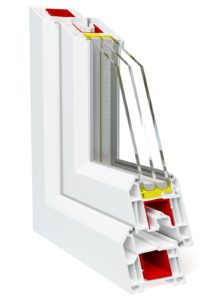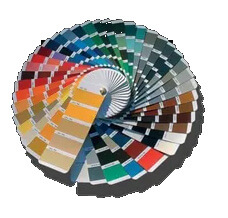Architect Collection uPVC windows
Windows in this series have a 2.8″ frame width. Due to the wide profile and 5 internal space the house retains heat in the winter and coolness in the summer. Two sealing circuits protect against drafts. The profile allows the installation of triple-glazed windows with a maximum width of 1.8″, which significantly improves the acoustic insulation and energy efficiency of the window.

What is the most energy efficient window?
In the order of most-to-least efficient:
- Fixed window (that does not open)
- Multi-lock casement window such as My Smarter Window, that utilizes European Tilt-and-Turn technology
- Traditional casement window
- Double hung window
While window energy efficiency is a complex subject, we can boil it down to 2 main considerations:
- resistance to energy transfer (both in the summer and winter) – which is measured by U-value,
- and protection against direct solar energy – which is measured by SHGC, and commonly called “solar factor”.
Depending on the climate zone, U-value or solar factor may be more relevant.
U-value is important when the temperature inside and outside is significantly different (20F outside, 65F inside or 100F outside and 65F inside), while the solar factor is important when there is an unwanted direct sun. An energy efficient window is expected to have a U-value of 0.25 and SHGC of 0.3 (or lower).
The energy efficiency of the window is based on 3 components of the window:
- the glazing,
- the frame/sash,
- and closing mechanism.
Let’s quickly review each one:
- Glazing: the glazing is the largest part of the window and thankfully, the easiest to quantify: NFRC-certified labs can perform simple computer simulations to determine energy efficiency of the glazing. Energy efficient glazing will universally have Low-E tint, Argon fill and could come in double or triple pane.
- Frame/sash: while frame/sash do not allow any direct light, they can certainly transfer heat or cold into the house. Multi-chamber uPVC, fiberglass and wood all have excellent properties. If considering metal (aluminum or steel), it must be thermally-broken to prevent direct energy transfer.
- Closing mechanism: How well the window actually seals when closed vary greatly on window type, materials used and how well the window has been installed. Also a very important consideration – how will window accommodate movement of the house throughout the season and settling of a newly built home. A window with excellent glazing and frame can have horrible energy efficiency if it simply does not close well! And unfortunately, this does not AT ALL factor into the U-value rating of a window. For example, a customer could buy an $800 double-hung window with U-value of 0.25, have it installed improperly (out of square) and experience drafts and terrible energy efficiency.
So, drawing on the above, an energy-efficient window must have
- Quality glazing: Low E glass, argon fill. Triple pane is not necessary, but will help.
- Quality components, avoid non-thermal-broken aluminum
- Closing mechanisms: the most energy efficient closing mechanism would be a fixed (picture) window – it does not open, so there are no possible drafts.
Next would be a multi-lock casement window such as My Smarter Window, that utilizes European Tilt-and-Turn technology. The multi-lock system and multiple weather stripping eliminate any drafts, so that a closed window acts as if it was a fixed window.
Next would be a traditional casement window that features 2 lock system. Unfortunately, two locks on a sufficiently large window is not enough and does not eliminate drafts.
And finally, the least energy efficient window is the traditional double hung window that does not provide for any meaningful protection against drafts, especially after weather stripping has had time to age and become brittle.
To set up a window service consultation, please contact us at your convenience. We look forward to meeting you soon
My Smarter Window
345 Fairbrook Circle, Marietta, GA 30067, US

